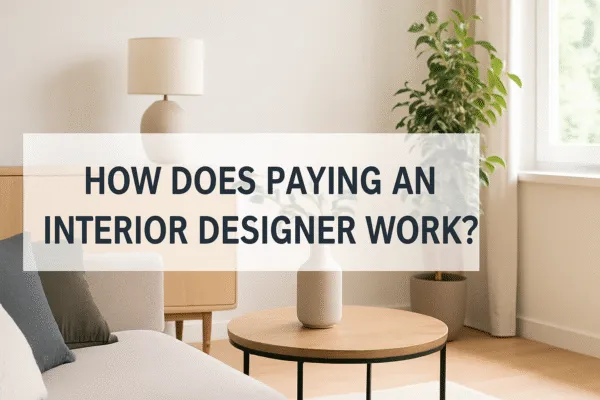
How Does Paying an Interior Designer Work?
Introduction
Hiring an interior designer is an exciting step toward transforming your home or business into a stylish, functional, and personalized space. Yet, for many clients, one of the biggest questions remains: how does paying an interior designer work?
In Palm Desert, CA—where design sophistication meets desert elegance—working with the best Interior Designer in California means understanding not only the creative process but also the financial investment involved. Payment structures in interior design can vary widely depending on the scope of the project, the designer’s expertise, and the client’s goals.
This article explains the different payment models interior designers use, factors that influence costs, and why investing in a professional designer ultimately adds significant value.
Why Payment Structures Matter
Interior design is not a one-size-fits-all service. Every project comes with its own requirements, from space planning and materials selection to construction management and décor styling. The way a designer charges ensures that both their time and expertise are fairly compensated, while clients get the results they expect.
For the best Interior Designer in California, transparent pricing models build trust, set clear expectations, and allow clients to make informed decisions about their budgets.
Common Payment Models for Interior Designers
1. Hourly Rate
Many designers charge by the hour, especially for small projects or consultations.
Range: $75–$250 per hour depending on expertise and region.
Best for: Smaller design tasks or when clients want to test a designer’s services.
Advantage: Flexible, clients pay only for hours worked.
Drawback: Costs can add up if the project requires more time than expected.
2. Flat Fee
Some designers offer a flat fee for the entire project.
How it works: The designer estimates time, materials, and scope, then sets one total price.
Best for: Well-defined projects such as designing one room or an entire home.
Advantage: Predictable cost and easier budgeting.
Drawback: Changes to the project scope may result in additional charges.
3. Percentage of Project Cost
Many designers base their fees on a percentage of the total project budget (typically 10–30%).
Example: If the project budget is $100,000, the fee could be $10,000–$30,000.
Best for: Large-scale renovations, luxury builds, or commercial projects.
Advantage: Designer is motivated to maximize quality within budget.
Drawback: Higher project costs mean higher designer fees.
4. Cost-Plus or Markup Model
Designers purchase furnishings, finishes, and materials at trade or wholesale discounts, then charge clients the retail price (or add a markup of 10–30%).
Advantage: Clients gain access to exclusive products.
Drawback: Can feel less transparent unless itemized invoices are provided.
5. Retainer Fees
Many designers require an upfront retainer before beginning work.
Purpose: Secures the designer’s time, covers initial planning, and demonstrates client commitment.
Often credited toward final invoices.
Factors That Affect How Designers Get Paid
Scope of Work: Designing one living room vs. overseeing a full-home remodel.
Experience: The best Interior Designer in California commands higher rates than newer designers.
Location: In Palm Desert, luxury and resort-style homes often involve premium design fees.
Timeline: Expedited projects may require higher costs.
Customization: Bespoke furniture, finishes, or artwork require more designer involvement.
Why Hiring an Interior Designer is Worth It
While paying a designer is an investment, the benefits outweigh the costs:
Avoiding costly mistakes.
Access to trade-only discounts.
Saving time and reducing stress.
Creating personalized, functional, and lasting designs.
Increasing property value.
For clients in Palm Desert, CA, these benefits are especially important in a competitive real estate and hospitality market.
How Clients Should Prepare for Payment
Discuss payment terms upfront.
Request a written contract detailing fees, timelines, and scope.
Clarify inclusions and exclusions. Some fees may not cover materials or contractor costs.
Budget realistically. Factor in unexpected expenses.
Stay engaged. Regular communication helps prevent financial surprises.
Example in Palm Desert
Imagine a luxury home renovation in Palm Desert requiring space planning, furniture design, and custom lighting. The best Interior Designer in California might charge a flat fee for design concepts and a percentage of the project budget for execution. Additionally, trade discounts on furniture would save the client thousands, balancing out designer fees.
Conclusion
Paying an interior designer can work through hourly rates, flat fees, percentages of project cost, cost-plus markups, or retainers. Each model has pros and cons, but all aim to fairly compensate the designer while ensuring clients get high-quality results.
For homeowners and businesses in Palm Desert, CA, partnering with the best Interior Designer in California means not only achieving stunning spaces but also gaining peace of mind with transparent payment structures and long-term value.
10 Frequently Asked Questions (FAQs)
1. What’s the most common way interior designers charge?
Flat fees and percentage-based models are most common for larger projects.
2. Do I need to pay upfront?
Yes, most designers require a retainer before starting work.
3. Can I hire a designer just for a consultation?
Yes, many charge hourly for consultations without full-service commitments.
4. Does hiring the best Interior Designer in California cost more?
Yes, but you benefit from expertise, access to resources, and long-term savings.
5. Do designers charge for shopping and sourcing time?
Yes, time spent sourcing materials is typically billed.
6. Is the cost of materials included in designer fees?
Not usually—materials, furniture, and contractor costs are billed separately.
7. How do I know if I’m being charged fairly?
Request itemized invoices and compare rates with industry standards.
8. Do designers pass on trade discounts to clients?
Some do; others use a cost-plus model to cover overhead.
9. Can fees change during a project?
Yes, if the scope expands or unexpected issues arise.
10. Is hiring an interior designer worth the money?
Absolutely. Designers save time, reduce stress, and increase property value.



